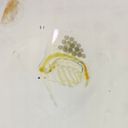Water Fleas
Cladocera
Classification
- Phylum: Arthropoda
- Subphylum: Crustacea
- Class: Branchiopoda
- Order: Diplostraca
- Suborder: Cladocera
Pronunciation
How to pronounce Cladocera: /kləˈdɒsərə/
These audio files are automatically generated. While they are not always 100% accurate, they are a good starting point.
Images






Summary
Cladocera, or water fleas, are small freshwater crustaceans characterized by their unique morphology and reproductive strategies, notably cyclical parthenogenesis, allowing them to thrive in various aquatic environments.
Physical Characteristics
Body less than 5 mm long, covered by a thin carapace that does not enclose the head. Head down-turned with a single compound eye and two pairs of antennae. Body not obviously segmented, with lobed appendages on the thorax.
Identification Tips
Look for the distinctive setae pattern on the second antennae, and the presence of a cervical sinus may help in differentiating species.
Habitat
Aquatic habitats, commonly found in freshwater environments including vernal pools.
Distribution
Over 1,000 recognized species globally, many remain undescribed, with cosmopolitan distributions due to the ability to produce dormant eggs.
Diet
Feeds primarily on detritus, algae, and bacteria; some species are also predatory.
Life Cycle
Lifecycle dominated by cyclical parthenogenesis; females produce clones asexually under favorable conditions and transition to sexual reproduction that creates dormant eggs in harsher conditions.
Reproduction
Primarily asexual reproduction through parthenogenesis; sexual reproduction occurs later in the season to produce drought-resistant eggs.
Ecosystem Role
Serves as a key component in aquatic food webs, feeding on organic matter and serving as prey for larger aquatic organisms.
Collecting Methods
- Net sampling in freshwater habitats
- Sediment sampling from lakes and ponds
Preservation Methods
- Fixation in ethanol or formaldehyde
- Freeze-drying for long-term storage
Evolution
Originated significantly earlier than their first fossils found in the Jurassic; modern forms suggest a lineage that stretches back to the Paleozoic.
Misconceptions
Often misidentified due to their small size and resemblance to other small crustaceans.
Tags
- Aquatic crustaceans
- Freshwater biology
- Parthenogenesis
- Zooplankton
- Daphnia